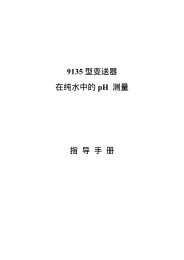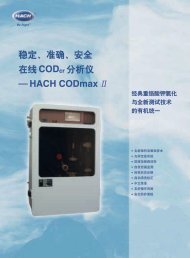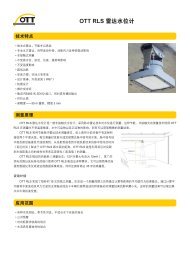TOC Analysis Moving from Laboratory Testing to On-line Analysis
TOC Analysis Moving from Laboratory Testing to On-line Analysis
TOC Analysis Moving from Laboratory Testing to On-line Analysis
You also want an ePaper? Increase the reach of your titles
YUMPU automatically turns print PDFs into web optimized ePapers that Google loves.
combined with a ‘main’ and ‘standby’ UV lamp arrangement, so that on detecting the ‘main’ UV lamp<br />
failure, the analyser can au<strong>to</strong>matically switch <strong>to</strong> the ‘standby’ UV lamp and continue <strong>to</strong> moni<strong>to</strong>r on-<strong>line</strong><br />
<strong>TOC</strong> whilst raising an alarm so that the maintenance team can replace the failed UV lamp in a timely<br />
manner.<br />
VERIFYING ON-LINE <strong>TOC</strong> ANALYSERS<br />
Unlike the membrane-based analysers used for labora<strong>to</strong>ry <strong>TOC</strong> analysis the on-<strong>line</strong> <strong>TOC</strong> analyser must<br />
be robust, have a stable calibration and be capable of consistent, repeatable analysis under varying<br />
sample temperatures, pressure and flow-rates.<br />
Figure 4: <strong>TOC</strong> analysers use temperature-compensated conductivity measurement<br />
<strong>TOC</strong> analysers are basically temperature-compensated differential conductivity instruments using UV light<br />
<strong>to</strong> oxidise the organic material <strong>to</strong> CO2 and utilising before-and-after-conductivity measurements as a<br />
surrogate measurement for <strong>TOC</strong>. They must be able <strong>to</strong> accurately moni<strong>to</strong>r the temperature of the sample<br />
as it is analysed <strong>to</strong> ensure that the final conductivity measurement is compensated for temperature<br />
change, otherwise the small change in conductivity caused by the CO2 evolved <strong>from</strong> the oxidised <strong>TOC</strong> will<br />
be swamped by the change in conductivity due <strong>to</strong> the temperature change in the sample.<br />
Hence it is important <strong>to</strong> verify:<br />
a) the calibration of conductivity meter used <strong>to</strong> measure <strong>TOC</strong><br />
b) the calibration of the temperature compensation sensor<br />
c) the <strong>TOC</strong> meter calibration against USP-traceable <strong>TOC</strong> standards<br />
d) system suitability<br />
e) the UV lamps<br />
a) Verifying the calibration of the conductivity meter used <strong>to</strong> measure <strong>TOC</strong><br />
Guidance was given in USP30 regarding the calibration verification conductivity meters. This<br />
was split in<strong>to</strong> two parts: meter calibration and cell constant. Hach Ultra provides an SOP for carrying<br />
these tests out on the Anatel PAT700 <strong>TOC</strong> analyser: SOP 700-4.<br />
Meter calibration verification is made by disconnecting the measurement cell and replacing it with a<br />
known-value NIST-traceable resis<strong>to</strong>r. Cell constant is verified by running a certified conductivity<br />
sample through the measurement cell.<br />
<strong>TOC</strong> <strong>Analysis</strong> – <strong>Moving</strong> <strong>from</strong> labora<strong>to</strong>ry <strong>to</strong> on-<strong>line</strong> moni<strong>to</strong>ring.<br />
March 2008 by Hach Ultra<br />
4 of 7






